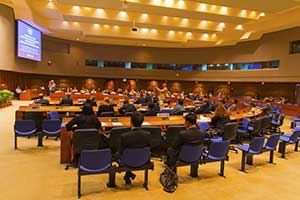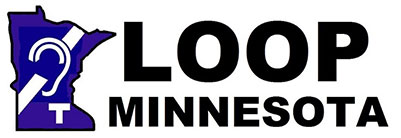COVID-19? Need for Hearing Loops & T-coils

Growing communications challenges
As the COVID-19 pandemic rages on, communication challenges of all kinds have turned into an acute issue for those with hearing loss. Speechreading (lipreading) has become impossible during these times of social distancing, masked outings and muffled conversations. Being talked to through plastic or glass partitions contributes to the further dulling of sounds.
As society gradually reopens ever so hesitantly, continued distancing and mask requirements will remain in effect and so will the communication hurdles. Sitting up front, close to the speaker is a thing of the past. “Up close” is a lot further back these days.
Now is the time to advocate for communication access
Wouldn’t it be nice to connect via telecoil or T-coil to hearing loops installed at bank and pharmacy windows, at information desks, in class rooms, libraries, places of worship and in health facilities? Gone would be the background noise and speech would be so much easier to understand – without the struggle, the fatigue and the embarrassment. Hearing loops are especially helpful in large, noisy venues such as convention and meeting rooms.
It is often said that anybody who has ever listened to speech through a correctly installed hearing loop does not want to turn back. As we go forward into a shaky communication future, it is more important than ever for people with hearing loss to get involved and to stand up for communication access. Let’s not be left out – again!
Visit this website and learn about it
The problem is that many people do not know much – or anything at all -about this technology. Non-proprietary hearing loops are different from proprietary, short-distance Bluetooth. A hearing loop is a special electrical wire that is installed throughout or around the area that is to be made accessible.
Telecoils or T-coils are tiny wireless antennas that can be found in cochlear implants, hearing aids and hearing devices large enough to accommodate them. They allow the user to tap into the sound energy carried by the magnetic field that surrounds a hearing loop that is in active service. Together, loops and telecoils act as assistive listening “systems.”
Do your hearing aids have telecoils?
Find out! Now is also the time to ask hearing specialists if the hearing aids that you plan to buy – or have already bought -have telecoils. Most people do not know because they have never told about them. Yet, in order for them to work, the hearing specialist must “activate” the telecoils and tune them to the hearing needs of the client. He/she must also instruct the client on how and where to use them.
The future of access is up to the people
In the end, do people with hearing loss want to be connected and included as communication snags pile up? If yes, it is time to act. Hearing loops do not magically appear. The technology needs advocates and believers who make the case for much-needed accessibility.
And so, what will our communication future look like? As President Abraham Lincoln told us “The best way to predict the future is to create it.” And the time to become “creative” and motivated is now.
Monique Hammond, VP Loop Minnesota
*****
Also, visit my website: hearing-loss-talk.com. I blog about all sorts of topics related to hearing and hearing loss.
